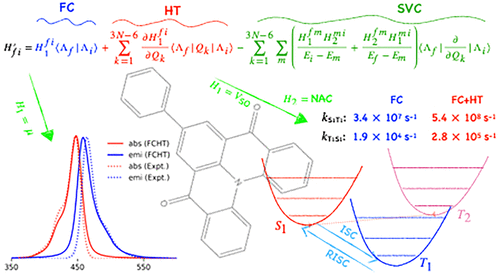当前位置:
X-MOL 学术
›
J. Phys. Chem. A
›
论文详情
Our official English website, www.x-mol.net, welcomes your
feedback! (Note: you will need to create a separate account there.)
Vibronic Coupling Effect on the Vibrationally Resolved Electronic Spectra and Intersystem Crossing Rates of a TADF Emitter: 7-PhQAD
The Journal of Physical Chemistry A ( IF 2.7 ) Pub Date : 2022-01-06 , DOI: 10.1021/acs.jpca.1c08456 Sirong Lin 1 , Zheng Pei 1 , Bin Zhang 1 , Huili Ma 2 , WanZhen Liang 1
The Journal of Physical Chemistry A ( IF 2.7 ) Pub Date : 2022-01-06 , DOI: 10.1021/acs.jpca.1c08456 Sirong Lin 1 , Zheng Pei 1 , Bin Zhang 1 , Huili Ma 2 , WanZhen Liang 1
Affiliation

|
Assessing and improving the performance of organic light-emitting diode (OLED) materials require quantitative prediction of rate coefficients for the intersystem crossing (ISC) and reverse ISC (RISC) processes, which are determined not only by the energy gap and the direct spin–orbit coupling (SOC) between the first singlet and triplet excited-states at a thermal equilibrium position of the initial electronic state but also by the non-Condon effects such as the Herzberg–Teller-like vibronic coupling (HTVC) and the spin-vibronic coupling (SVC). Here we apply the time-dependent correlation function approaches to quantitatively calculate the vibrationally resolved absorption and fluorescence spectra and ISC/RISC rates of a newly synthesized multiple-resonance-type (MR-type) thermally activated delayed fluorescence (TADF) emitter, 7-phenylquinolino[3,2,1-de]acridine-5,9-dione (7-PhQAD), with the inclusion of the Franck–Condon (FC), HTVC, and Duschinsky rotation (DR) effects. The SVC effect on the rates has also been approximately evaluated. We find that the experimentally measured ISC rates of 7-PhQAD originate predominantly from the vibronic coupling, consistent with the previous reports on other MR-type TADF emitters. The SVC effect on ISC rates is about 10 times larger than the HTVC effect, and the latter increases the ISC rates by more than 1 order of magnitude while it slightly affects the vibrationally resolved absorption and fluorescence spectra. The discrepancy between the theoretical and experimental results is attributed to inaccurately describing excited-states calculated by the time-dependent density functional theory as well as to not fully accounting for the complex experimental conditions. This work provides a demonstration of what proportion of ISC and RISC rate coefficients of a MR-type TADF emitter can be covered by the HTVC effect, and it opens design routes that go beyond the FC approximation for the future development of high-performance OLED devices.
中文翻译:

振动耦合对 TADF 发射器的振动分辨电子光谱和系统间交叉率的影响:7-PhQAD
评估和改进有机发光二极管 (OLED) 材料的性能需要对系统间交叉 (ISC) 和反向 ISC (RISC) 过程的速率系数进行定量预测,这不仅取决于能隙和直接自旋-在初始电子态的热平衡位置处的第一个单重激发态和三重激发态之间的轨道耦合 (SOC) 以及非康登效应,例如 Herzberg-Teller 类振动耦合 (HTVC) 和自旋振动耦合耦合(SVC)。在这里,我们应用时间相关函数方法来定量计算新合成的多共振型(MR 型)热激活延迟荧光(TADF)发射器的振动分辨吸收和荧光光谱以及 ISC/RISC 率,7-苯基喹啉[3,德]吖啶-5,9-二酮 (7-PhQAD),包括 Franck-Condon (FC)、HTVC 和 Duschinsky 旋转 (DR) 效应。SVC 对利率的影响也进行了近似评估。我们发现实验测量的 7-PhQAD 的 ISC 率主要来自振动耦合,这与之前关于其他 MR 型 TADF 发射器的报道一致。SVC 对 ISC 率的影响大约是 HTVC 效应的 10 倍,后者将 ISC 率提高了 1 个数量级以上,同时对振动分辨吸收和荧光光谱有轻微影响。理论和实验结果之间的差异归因于时间依赖性密度泛函理论计算的激发态描述不准确以及没有充分考虑复杂的实验条件。这项工作证明了 HTVC 效应可以覆盖 MR 型 TADF 发射器的 ISC 和 RISC 速率系数的比例,并为未来高性能 OLED 器件的发展开辟了超越 FC 近似的设计路线.
更新日期:2022-01-20
中文翻译:

振动耦合对 TADF 发射器的振动分辨电子光谱和系统间交叉率的影响:7-PhQAD
评估和改进有机发光二极管 (OLED) 材料的性能需要对系统间交叉 (ISC) 和反向 ISC (RISC) 过程的速率系数进行定量预测,这不仅取决于能隙和直接自旋-在初始电子态的热平衡位置处的第一个单重激发态和三重激发态之间的轨道耦合 (SOC) 以及非康登效应,例如 Herzberg-Teller 类振动耦合 (HTVC) 和自旋振动耦合耦合(SVC)。在这里,我们应用时间相关函数方法来定量计算新合成的多共振型(MR 型)热激活延迟荧光(TADF)发射器的振动分辨吸收和荧光光谱以及 ISC/RISC 率,7-苯基喹啉[3,德]吖啶-5,9-二酮 (7-PhQAD),包括 Franck-Condon (FC)、HTVC 和 Duschinsky 旋转 (DR) 效应。SVC 对利率的影响也进行了近似评估。我们发现实验测量的 7-PhQAD 的 ISC 率主要来自振动耦合,这与之前关于其他 MR 型 TADF 发射器的报道一致。SVC 对 ISC 率的影响大约是 HTVC 效应的 10 倍,后者将 ISC 率提高了 1 个数量级以上,同时对振动分辨吸收和荧光光谱有轻微影响。理论和实验结果之间的差异归因于时间依赖性密度泛函理论计算的激发态描述不准确以及没有充分考虑复杂的实验条件。这项工作证明了 HTVC 效应可以覆盖 MR 型 TADF 发射器的 ISC 和 RISC 速率系数的比例,并为未来高性能 OLED 器件的发展开辟了超越 FC 近似的设计路线.


















































 京公网安备 11010802027423号
京公网安备 11010802027423号